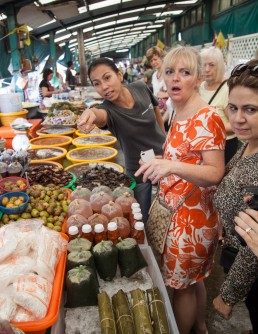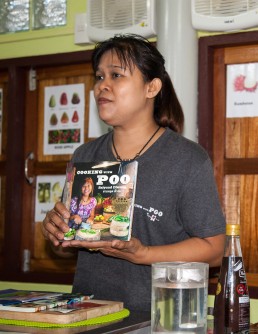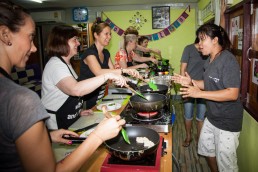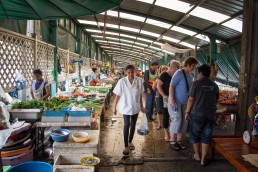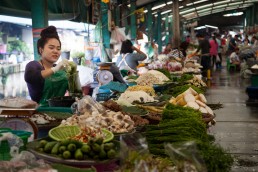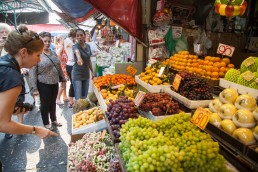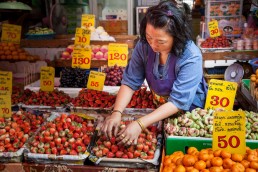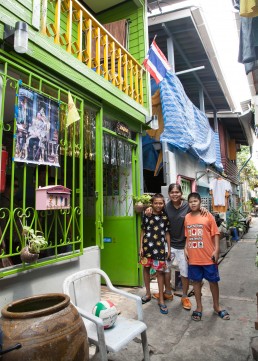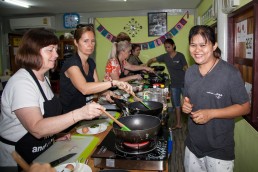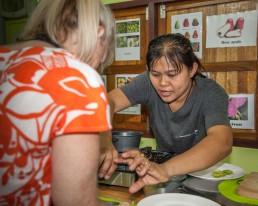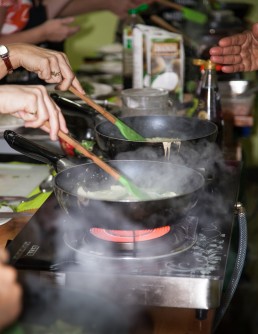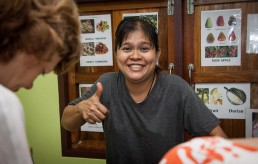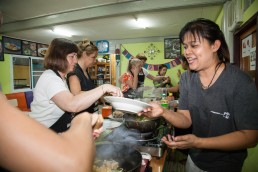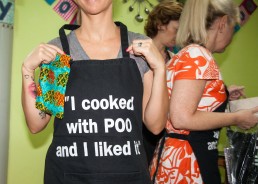Saiyuud 'Poo' Diwong, a home-taught cook working out of Bangkok's biggest slum, captured hearts with her inspiring story and quirky book of recipes. After a fire threatened to destroy everything, she's back in business with a new cookery school.
IN 2012, THE WORLD’S media gleefully reported that a Thai cookbook — in competition with Estonian Sock Patterns All Around the World and A Century of Sand Dredging in the Bristol Channel — had won an international prize for the oddest book title of the year.
The giggle-inducing Cooking with Poo was the work of Saiyuud Diwong, who is better known by her nickname — which is short for Chompoo, or “rose apple”, in Thai — and a long-time resident of Klong Toey, the largest and most notorious slum in Bangkok.
At the time, Poo had been running an unpretentious cooking school in Klong Toey for only a few years. The result of the book’s triumph — and all the subsequent publicity — was swift.
THOUGH POO’S MODEST operation was already popular, employing slum neighbours and proving a model of positivity in a bleak landscape of poverty and despair, suddenly she was being feted by gastronomy’s great and good.
British celebrity chef Jamie Oliver shared the cover of Cooking With Poo on Instagram and the book became a quirky Christmas stocking-filler worldwide. Media tours of Australia and the UK followed — with Poo energetically knocking up a massaman curry with Oliver for TV cameras — and the curious pounded a beat to ramshackle Klong Toey in increasing numbers. Five-star reviews piled up on TripAdvisor.
Then, in August last year, disaster stuck: a fire started in a nearby home reduced Poo’s immediate neighbourhood to ashes. Her cooking school had gone up in smoke. But you can’t keep a self-proclaimed “superwoman” down — and now, after a rebuild and refit, the unlikely culinary entrepreneur is back in business.
Cooking With Poo: Number Two, anyone?
“Life was hard work — 12 hours a day. I’d start work at 5am every day, no holiday. A lot of people in my area did the same”
Saiyuud ‘Poo’ Diwong
A Cooking with Poo class starts with a tour of Klong Toey’s labyrinthine outdoor market. On the Thursday that I join a class, Noi and Tai, two of Poo’s team of helpers, lead 10 new students through aisles jammed tight with mountains of young coconuts and mangos, overflowing bamboo baskets of holy basil, mint and coriander, writhing catfish and monster eels, decapitated frogs, waxy pig heads and so much more, all at rock-bottom prices.
Grinning ear to ear, Poo is waiting outside her school when we arrive, welcoming us into a single room of perhaps 250 square feet. Walls are painted a pleasing lime green and photos and posters of Thai dishes and beaches decorate the space. The atmosphere is more cash-strapped kindergarten than international school of learning.
Poo remembers life before she opened the school, when she sold food to neighbours from her home in the slum, making just Bt200 (then about US$7) a day. “Life was hard work — 12 hours a day,” she says. “I’d start work at 5am every day, no holiday. A lot of people in my area did the same.”
One of Poo’s regular customers was Anji Barker, an Australian aid worker. When soaring produce prices saw Poo struggle to make a living, Barker suggested she open a cooking school. After an intensive effort to learn English (“Back then I could only say ‘yes, okay, no, thank you’”), Poo managed to rustle up a successful business.
THE “VERY QUICK, very easy” dishes on Poo’s menu lean towards the street-food end of the culinary spectrum, with different dishes made each day of the week. Options include coconut chicken soup, green papaya salad and minced duck with lemongrass. Today we will attack three Thai staples: spicy beef salad, pad thai noodles with prawns, and green chicken curry.
Decked out in aprons emblazoned with the words “I cooked with POO and I liked it”, we get to work on the beef salad, chopping lemongrass, kaffir lime leaves and spring onions just so. Poo strolls among her charges, offering an encouraging thumbs up here and a useful tip or two there. “If you don’t like spicy, slice the chillies bigger,” she advises. “For me, I use five chillies, but for you, maybe just one.”
Poo’s signature recipe of smiles and banter continues through the pad thai (“put the bean sprouts in later if you like crunchy”; “cut the spring onions bigger — nice colour”). She is accustomed to foreign visitors’ preference for a healthier approach than what’s typical in the slum, and she avoids oil, products with colourings (such as the yellow tofu popular in pad thai) and sugar as much as possible. “Thai people loooove sugar,” she says, laughing.
Poo tells her story to Jamie Oliver. Video: Jamie Oliver/YouTube
POO’S HEALTHY APPROACH extends to the green curry, and she rejects ready-made solutions for the from-scratch approach, crushing galangal, lime rind, chilli, lemongrass, garlic and onion into a kryptonite-green paste with a pestle and mortar.
“When I was young and cooking with my mother, I hated the pestle and mortar,” she says, lifting a T-shirt sleeve to flash a meaty bicep. “It was one kilo, so now I have very big muscles. It’s good exercise. Makes a woman a superwoman!”
The four hours of the class rush by and end with most students purchasing the now-famous Cooking with Poo book, and maybe an apron or a T-shirt. And before waving goodbye, Poo shrugs when asked about the fire that nearly tore up her recipe for success.
“The bad luck is gone; the good luck is back,” she says, smiling yet again. “We can have a holiday, we can have a long weekend, plus we are helping others in the slum. We can put money in the bank, and together we have hope and sweet dreams. I’m very proud.” ◉
This story ran in Hong Kong’s South China Morning Post in April 2015. The operation has grown to become Cooking with Poo & Friends. Price and booking via cookingwithpoo.com.
SHARE


